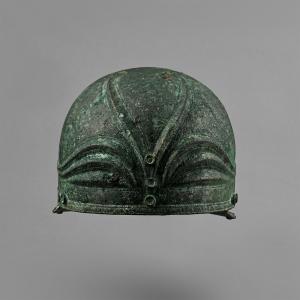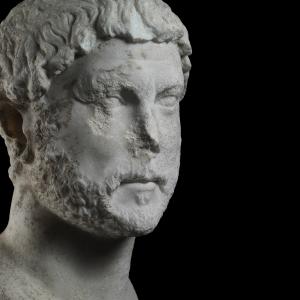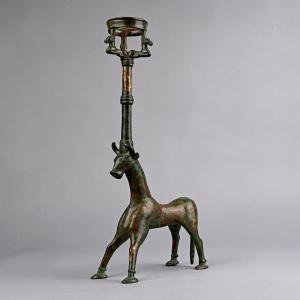Prized ancient art and antiquities from estate of top British collector to highlight TimeLine's Sept. 9-13 auction

Egyptian limestone bas-relief panel depicting Ptah presiding over the smelting of metals. Old Kingdom, 5th Dynasty, 2498-2345 B.C. One of the earliest known depictions of ancient technology. Estimate: £80,000-£100,000/$107,160-$133,950

Rare and important Roman Imperial legionary army helmet with four embossed 'wings,' late 1st century BC to early 1st century AD. Estimate: £8,000-£10,000/$10,720-$13,400

Twice-life-size white marble portrait of Emperor Hadrian, one of Rome’s greatest emperors and builder of Hadrian’s Wall. Created 126-140 A.D., during the Hadrianic Period. Estimate: £80,000-£100,000/$107,160-$133,950
Opening session of 415 premier objects includes twice-life-size marble head of Hadrian, Egyptian panel showing Ptah with metalworkers, Mesopotamian torch bearer
The sale is highlighted by Part I of the premier estate collection of the late John P Meredith, a lifelong collector and antiquities connoisseur from Cornwall, England. Numbering more than 400 items in total, the widely-varied assemblage includes Egyptian, Medieval, Greek, Near Eastern, Western Asiatic and Indus Valley antiquities, as well as extraordinary mineral specimens and a world-class specialty collection of ancient Celtic coins.
According to his family, Mr Meredith started collecting in the 1990s. “Multiple generations of his family were influenced by his passion for historical objects, including his grandchildren. Whenever they visited, they would make a beeline to see his collection, which he proudly displayed in glass cabinets. He would enthusiastically discuss the history of the collection with the youngsters, which surely made a positive impression,” said Aaron Hammond, chief operating officer of TimeLine Auctions.
An outstanding selection of fresh-to-market pieces from history’s most celebrated cultures has been reserved for the September 9 opening session, including many superb examples of ancient statuary that pay tribute to actual historical and noble figures.
The tradition of immortalizing dignitaries in marble and other prized materials has been embraced by cultures throughout history. In ancient Rome, military heroes or nobles were frequently chosen as subjects for major statuary. A fine example of this form of homage is seen in the auction’s twice-life-size white marble portrait of Emperor Hadrian, one of Rome’s greatest emperors and the builder of Hadrian’s Wall in England. Created 126-140 AD, during the Hadrianic Period, this characteristic portrait of Hadrian shows his hair arranged in wavy strands swept forward from the crown and terminating in a row of lively curls that frame his forehead and temples. He sports a thick, curly beard – unusual for Hadrian’s time – and has a thoughtful expression on his face. The attitude of his head suggests the portrait once belonged to a full-length statue or to a bust. Its provenance can be traced to a February 1988 purchase on the Swiss art market. Most recently, it was part of a Liechtenstein private collection. The artwork is estimated at £80,000-£100,000/$107,160-$133,950 and will convey with an academic report from Dr Raffaele D’Amato.
An extremely fine Roman marble portrait bust of an aristocratic woman from the Julio-Claudian Period, circa 50-60 AD, depicts the sitter with a dignified expression, and her hair arranged in tight curls with small braids gathered and tied at the back. This artwork has a distinguished line of European provenance dating back to its pre-1910 acquisition by Professor Elia Volpi (1858-1938) in Florence, Italy. Most recently, it was sold at Hindman (Chicago) on May 25, 2023. Published in several old references, the bust will convey to its next owner with an academic report from Dr D’Amato. Estimate: £30,000-£40,000/$40,190-$53,580
Certainly one of the most fascinating pieces in the auction is an Egyptian limestone bas-relief panel depicting Ptah (patron deity of craftsmen and architects) presiding over the smelting of metals. From the Old Kingdom, 5th Dynasty, 2498-2345 BC, it is one of the earliest known depictions of ancient technology. Three male figures are shown in tied kilts and short hairstyles, preparing to smelt copper. Two of them are carrying a small furnace. Finely-rendered hieroglyphic inscriptions in front of each figure record a dialogue whose translated commentary includes “Ptah could not have done better” and “Ptah loves him to pour into the brazier of the flame,” etc. It is comparable to an example illustrated in W.C. Hayes’ The Scepter of Egypt which is described as having come from the tomb of Re-em-kuy. Its provenance includes Touric Arakji (Hamburg, Germany), acquired by circa 1980; Sotheby’s June 8, 1994 auction; and subsequent London gallery and private collections. Accompanied by academic report from Egyptologist Sylvie Caroff, it is estimated at £80,000-£100,000/$107,160-$133,950.
An Assyrian gypsum relief prominently featuring the head of a bearded man dates to 704-681 BC. Rectangular in shape, it is a frieze fragment of a type that once decorated the walls of royal palaces. The low-relief carving depicts a man in profile with short, straight hair confined by a brow-band, with segmented curls forming his beard. A handwritten label on verso reads: “from the Koyunjik palace of Sennacherib at Nineveh.” The incised legend says “KOUUNJIK” and “A.” its line of provenance begins with acquisition in the 1970s by a British gentleman and culminates most recently (2009) in a private European collection. With its custom stand, it is offered with an £8,000-£10,000/$10,720-$13,400 estimate.
Another Near Eastern treasure is a museum-quality Mesopotamian bronze torch bearer from the Early Dynastic Period II, mid 3rd Millennium BC. Linked to early ritual and ceremonial use, it portrays a bull standing with firmly-planted splayed legs, its tail extending to the ground, with an extended stem whose purpose was to secure a torch. The stem is adorned with three radiating feline figures, each supporting a post with a gusseted ring above. This spectacular bronze is similar to several book examples, as well as to a specimen with an ibex support in the Metropolitan Museum’s collection. Accompanied by an academic report from Dr D’Amato, it has been assigned a £70,000-£90,000/$93,770-$120,560 estimate.
Armor & Militaria is a consistently popular category with TimeLine’s buyers. The September 9 session does not disappoint with enticing entries such as a rare and important bronze legionary-army helmet from the Roman Imperial period, late 1st century BC to early 1st century AD. Described as being an “Imperial Gallic” type of helmet with a deep rounded bowl, C-shape cutouts for the ears, flared horizontal neck-guard, bronze rivets and four corrugated embossed “wings,” this relatively heavy example at 1.03kg (2lbs 4oz) is further enhanced by an embossed, beaded brow band that runs from one ear opening to the other. Most recently the property of a North London gentleman, it comes with a custom stand and an academic report from Dr D’Amato. Estimate: £20,000-£30,000/$26,790-$40,190
Nothing can rival ancient jewelry for sheer beauty and workmanship, as seen in a magnificent matched pair of Javanese gold zoomorphic ear ornaments made sometime between 1293 and 1530 AD. Of a highly-domed design, each displays a front-facing head of Garuda, the eagle-headed Vahana or celestial mount of Vishnu; is hollow-formed and exquisitely worked in repousse with a nimbate figure emerging from dense field of intricate floral motifs. Each is adorned on the reverse with the image of a repousse monkey. Pictured in J Polak’s 2022 reference Ancient Indonesian Gold of the Central and Eastern Javanese Periods, 750-1550, its long line of provenance can be traced back to a 1920s acquisition by a Dutch civil servant who took them to the Netherlands in 1939. Later, the pair was acquired by collector Frans H A Claessen, with subsequent descent through his family. Next, the ornaments became the property of a Hong Kong private collector and, most recently, they joined a London private collection. With a custom case, they are offered with a £40,000-£60,000/$53,580-$80,370 auction.
TimeLine’s Sept. 9-13, 2025 auction will be held live at the company’s head office located at The Court House, 363 Main Rd., Harwich, Essex CO12 4DN, UK. All lots featured in TimeLine’s hardcover catalogue will be auctioned during the September 9 opening session. Internet bidders may pre-register online. Goods may be previewed in person at the gallery by prior arrangement only. A special London viewing and champagne reception will be held at The Institute of Directors, 116 Pall Mall, St James’s, on Tuesday, September 2. Preview hours are 12 noon to 6pm, with the reception from 6-9pm and a talk by Kassia St Clair titled “Tyrian Purple: The Colour of Power” at 7:30pm. Additional viewing at The Institute will follow on Wednesday, September 3 from 9am-12 noon.
Auction start time: 7am US Eastern time/12 noon GMT. All remote forms of bidding will be available, including absentee, by phone (please book phone line 48 hours ahead of time), or live via the Internet through TimeLine’s bidding platform or LiveAuctioneers. TimeLine Auctions accepts payments in GBP and ships worldwide. Questions: call +44 7494 866514 or email Aaron Hammond at ah@timelineauctions.com. Online: https://timelineauctions.com.
Aaron Hammond
TimeLine Auctions
+44 7494 866514
ah@timelineauctions.com
Visit us on social media:
Facebook
Legal Disclaimer:
EIN Presswire provides this news content "as is" without warranty of any kind. We do not accept any responsibility or liability for the accuracy, content, images, videos, licenses, completeness, legality, or reliability of the information contained in this article. If you have any complaints or copyright issues related to this article, kindly contact the author above.


